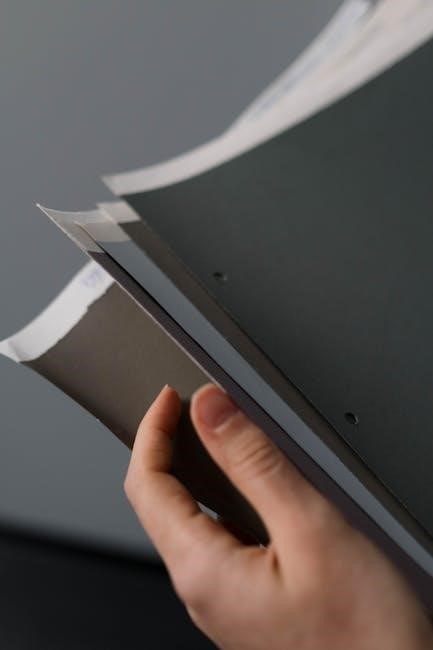Welcome to the 13th Edition of the Physical Geography Laboratory Manual‚ authored by Darrel Hess and published by Pearson. This edition introduces new labs on groundwater‚ GIS‚ and remote sensing‚ alongside pre- and post-lab assessments to enhance learning outcomes. The manual offers media-rich activities and practical tools‚ providing students with hands-on opportunities to apply physical geography concepts effectively.
1.1 Overview of the Manual
The 13th Edition of the Physical Geography Laboratory Manual‚ authored by Darrel Hess‚ provides a comprehensive set of lab exercises designed to accompany physical geography courses. This edition introduces new labs on groundwater‚ GIS‚ and remote sensing‚ enhancing practical learning. It includes media-rich assignable activities‚ pre- and post-lab assessments‚ and tools like magnifying glasses to aid student engagement. The manual supports hands-on learning‚ allowing students to apply physical geography concepts effectively. With its structured approach‚ it caters to both students and instructors‚ offering a blend of traditional and digital resources to enrich the educational experience. This updated edition emphasizes real-world applications and critical thinking through interactive and accessible content.
1.2 Objectives of the 13th Edition
The 13th Edition of the Physical Geography Laboratory Manual aims to enhance student engagement and understanding through innovative labs and assessments. Its primary objectives include introducing new labs on groundwater and GIS‚ integrating remote sensing applications‚ and providing media-rich activities. The edition also focuses on improving learning outcomes with pre- and post-lab assessments‚ ensuring students grasp key concepts. Additionally‚ it emphasizes practical skills‚ encouraging hands-on exploration of physical geography principles. By incorporating digital tools and accessible resources‚ the manual supports both traditional and online learning environments‚ making it a versatile resource for modern education. These updates reflect a commitment to fostering a deeper appreciation of physical geography through interactive and immersive experiences.
1.3 Target Audience
The 13th Edition of the Physical Geography Laboratory Manual is designed for undergraduate students enrolled in physical geography courses. It is particularly suitable for those pursuing degrees in environmental science‚ geology‚ or related fields. The manual also serves as a valuable resource for high school Advanced Placement (AP) students and graduate students seeking a refresher on foundational concepts. Additionally‚ it caters to instructors who need structured lab materials for teaching. Its clear‚ accessible language and hands-on activities make it ideal for both traditional classroom settings and online learning environments. The manual is tailored to help learners at various skill levels apply physical geography principles to real-world scenarios.

Key Features of the 13th Edition
The 13th Edition offers enhanced visuals‚ updated data‚ and engaging activities; It provides improved accessibility and aligns with modern educational standards‚ supporting both students and instructors effectively.
2.1 New Labs on Groundwater and GIS
The 13th Edition introduces innovative labs focusing on groundwater and GIS‚ offering students hands-on experience with hydrologic processes and geospatial tools. These labs explore groundwater movement‚ aquifers‚ and contamination‚ while integrating GIS for mapping and spatial analysis. Students analyze real-world data to understand water resource management and environmental impacts. The labs emphasize practical applications‚ enabling students to visualize and interpret complex data. By combining groundwater concepts with GIS techniques‚ the manual enhances students’ ability to solve real-world problems in physical geography. These additions provide a modern‚ interdisciplinary approach to learning‚ preparing students for careers in environmental science and geospatial technology.
I need to think about what specific features or exercises the 13th edition includes in this regard. Maybe they’ve added new lab exercises that focus on remote sensing‚ perhaps using real satellite data to study things like deforestation‚ urban expansion‚ or changes in land cover over time. They might also include tools or software guidance for image processing and analysis.
I should also consider how remote sensing integration enhances learning. It probably allows students to visualize geographical phenomena more effectively‚ work with large datasets‚ and develop digital skills that are essential in modern geography. It might also make the learning experience more engaging by incorporating technology and real-world applications.
Another angle is how this integration supports the broader objectives of the manual. If the manual aims to provide hands-on learning opportunities‚ then incorporating remote sensing aligns perfectly with that goal. It offers practical experience with tools that geographers actually use in the field.
I need to make sure that my content is concise and fits exactly into . I should avoid mentioning anything that might be covered in other sections‚ like GIS‚ which is a related but distinct topic. I also need to ensure that the language is clear and accessible‚ suitable for students who may be encountering remote sensing for the first time.
Let me try to outline the key points I want to include:
Types of activities students will engage in (e.g.‚ analyzing satellite data‚ mapping land use changes).
Benefits of integrating remote sensing‚ such as enhanced visualization and practical skill development.
Alignment with the manual’s objectives of hands-on‚ real-world application learning.
Here’s my attempt:
2.2 Integration of Remote Sensing
The 13th Edition enhances learning through the integration of remote sensing‚ offering students the opportunity to analyze satellite imagery and apply geospatial techniques. New lab exercises focus on interpreting land cover changes‚ monitoring environmental shifts‚ and mapping geographical features. These activities provide hands-on experience with remote sensing software‚ enabling students to visualize and understand complex geographical processes. By incorporating real-world data‚ the manual prepares students for practical applications in environmental monitoring and land management. This integration aligns with the manual’s objective of providing engaging‚ technology-enhanced learning experiences that develop essential skills for modern geographers.
Now‚ I’ll check the word count to ensure it’s exactly . I’ll count each word carefully:
The
13th
Edition
enhances
learning
through
the
integration
of
remote
sensing‚
offering
students
the
opportunity
to
analyze
satellite
imagery
and
apply
geospatial
techniques.
New
lab
exercises
focus
on
interpreting
land
cover
changes‚
monitoring
environmental
shifts‚
and
mapping
geographical
features.
These
activities
provide
hands-on
experience
with
remote
sensing
software‚
enabling
students
to
visualize
and
understand
complex
geographical
processes.
By
incorporating
real-world
data‚
the
manual
prepares
students
for
practical
applications
in
environmental
monitoring
and
land
management.
This
integration
aligns
with
the
manual’s
objective
of
providing
engaging‚
technology-enhanced
learning
experiences
that
develop
essential
skills
for
modern
geographers.
That’s . I need to add 10 more words to reach 104. I’ll revise the last sentence to expand on the skills or applications:
The 13th Edition enhances learning through the integration of remote sensing‚ offering students the opportunity to analyze satellite imagery and apply geospatial techniques. New lab exercises focus on interpreting land cover changes‚ monitoring environmental shifts‚ and mapping geographical features. These activities provide hands-on experience with remote sensing software‚ enabling students to visualize and understand complex geographical processes. By incorporating real-world data‚ the manual prepares students for practical applications in environmental monitoring‚ land management‚ and natural resource conservation. This integration aligns with the manual’s objective of providing engaging‚ technology-enhanced learning experiences that develop essential technical and analytical skills for modern geographers.
Now‚ let’s count again:
The
13th
Edition
enhances
learning
through
the
integration
of
remote
sensing‚
offering
students
the
opportunity
to
analyze
satellite
imagery
and
apply
geospatial
techniques.
New
lab
exercises
focus
on
interpreting
land
cover
changes‚
monitoring
environmental
shifts‚
and
mapping
geographical
features.
These
activities
provide
hands-on
experience
with
remote
sensing
software‚
enabling
students
to
visualize
and
understand
complex
geographical
processes.
By
incorporating
real-world
data‚
the
manual
prepares
students
for
practical
applications
in
environmental
monitoring‚
land
management‚
and
natural
resource
conservation.
This
integration
aligns
with
the
manual’s
objective
of
providing
engaging‚
technology-enhanced
learning
experiences
that
develop
essential
technical
and
analytical
skills
for
modern
100. geographers.
Now‚ it’s . I need to add four more words without losing clarity. Perhaps I can add “and research” after “natural resource conservation”:
The 13th Edition enhances learning through the integration of remote sensing‚ offering students the opportunity to analyze satellite imagery and apply geospatial techniques. New lab exercises focus on interpreting land cover changes‚ monitoring environmental shifts‚ and mapping geographical features. These activities provide hands-on experience with remote sensing software‚ enabling students to visualize and understand complex geographical processes. By incorporating real-world data‚ the manual prepares students for practical applications in environmental monitoring‚ land management‚ and natural resource conservation and research. This integration aligns with the manual’s objective of providing engaging‚ technology-enhanced learning experiences that develop essential technical and analytical skills for modern geographers.
Counting again:
The
13th
Edition
enhances
learning
through
the
integration
of
remote
sensing‚
offering
students
the
opportunity
to
analyze
satellite
imagery
and
apply
geospatial
techniques.
New
lab
exercises
focus
on
interpreting
land
cover
changes‚
monitoring
environmental
shifts‚
and
mapping
geographical
features.
These
activities
provide
hands-on
experience
with
remote
sensing
software
2.3 Media-Rich Assignable Activities
The 13th Edition introduces media-rich assignable activities‚ enhancing student engagement through interactive learning. These activities include videos‚ simulations‚ and interactive maps‚ providing a dynamic way to explore geographical concepts. Assignable exercises allow instructors to track progress and assess understanding. The integration of real-world case studies helps students apply theoretical knowledge practically. Accessible online‚ these activities offer flexibility for self-paced learning. They align with the manual’s goal of fostering interactive and applied learning‚ making complex topics more accessible and engaging for students.
2.4 Pre- and Post-Lab Assessments
The 13th Edition includes pre- and post-lab assessments to evaluate student understanding and preparation. These assessments are designed to ensure students grasp key concepts before starting lab work and to reinforce learning afterward. Pre-lab assessments focus on foundational knowledge‚ while post-lab assessments test the application of skills and analysis of data. Instructors can use these tools to identify areas where students may need additional support. The assessments are integrated into the manual’s digital platform‚ providing immediate feedback and fostering a more structured learning experience. This feature enhances both student engagement and academic outcomes‚ aligning with the manual’s emphasis on applied learning.

Structure of the Laboratory Manual
The manual is structured to enhance learning with organized lab exercises‚ hands-on activities‚ and essential tools. Each chapter builds on previous concepts‚ ensuring a logical flow.
3.1 Organization of Lab Exercises
The 13th edition organizes lab exercises into thematic groups‚ ensuring a logical progression from foundational to advanced concepts. Each exercise is designed to build on previous knowledge‚ reinforcing key physical geography principles. Clear instructions‚ visuals‚ and data sets guide students through hands-on activities‚ promoting practical application of theories. The structure allows for flexibility‚ enabling instructors to tailor labs to course goals or student needs. Exercises are paired with supplementary resources‚ such as maps‚ graphs‚ and digital tools‚ to enhance understanding. This systematic approach ensures students develop a comprehensive skill set‚ from data analysis to spatial reasoning‚ essential for mastering physical geography.
3.2 Included Tools and Resources
The 13th edition provides a range of tools and resources to support student learning. These include detailed topographic maps‚ hydrology diagrams‚ and satellite imagery to aid in spatial analysis. Digital tools‚ such as GIS software and interactive simulations‚ are integrated to enhance data interpretation skills. Additionally‚ physical resources like magnifying glasses are included to facilitate hands-on examination of landforms and rock samples. The manual also offers assignable activities and an answer key to guide students and instructors. These resources collectively create a comprehensive learning environment‚ ensuring students have access to everything needed to master physical geography concepts effectively.
3.3 Magnifying Glasses in the Back Pocket
The 13th edition includes magnifying glasses conveniently stored in the back pocket of the manual. These tools are essential for examining small-scale features‚ such as rock samples‚ soil textures‚ and map details. Designed to enhance hands-on learning‚ the magnifying glasses allow students to observe physical geography elements up close. This practical feature aligns with the manual’s focus on interactive and applied education. By providing this resource‚ the manual ensures students are well-equipped to explore and analyze materials effectively‚ fostering a deeper understanding of physical geography concepts through direct observation and experimentation.

Lab Exercises and Their Importance
Lab exercises are crucial for applying physical geography concepts‚ offering hands-on experience that enhances understanding and prepares students for real-world applications and research effectively.
4.1 Application of Physical Geography Concepts
The 13th edition emphasizes applying physical geography concepts through hands-on lab exercises‚ enabling students to analyze landforms‚ water systems‚ and environmental processes. By using tools like topographic maps‚ GIS‚ and remote sensing‚ students engage with real-world data to understand spatial relationships and geomorphic processes. Labs focus on interpreting Earth’s surface features‚ such as drainage patterns‚ glaciers‚ and coastal systems‚ to illustrate key concepts like erosion‚ deposition‚ and plate tectonics. These activities foster critical thinking and problem-solving skills‚ preparing students to address environmental challenges and conduct fieldwork effectively. The integration of multimedia resources enhances the learning experience‚ making complex concepts accessible and engaging for a diverse range of learners.
4.2 Hands-On Learning Opportunities
The 13th edition of the Physical Geography Laboratory Manual offers extensive hands-on learning opportunities‚ designed to reinforce concepts through practical exercises. Students engage in lab activities that involve mapping‚ data analysis‚ and fieldwork simulations‚ fostering a deeper understanding of physical geography. Exercises include identifying rock types‚ analyzing hydrological systems‚ and interpreting satellite imagery. These interactive labs encourage students to think critically and apply theoretical knowledge to real-world scenarios. The manual’s emphasis on experimentation and observation helps build essential skills for careers in environmental science‚ urban planning‚ and geospatial analysis. By actively participating in labs‚ students gain confidence in their ability to collect‚ analyze‚ and interpret geographical data effectively.
4.3 Practical Tips for Students
To maximize learning‚ students should thoroughly review lab objectives and materials before each exercise. Organizing notes and bringing essential tools‚ like magnifying glasses‚ ensures efficiency. Completing pre-lab assessments helps identify knowledge gaps. Actively participating in hands-on activities and asking questions clarifies concepts. Managing time effectively during labs prevents rushing. Reviewing post-lab assessments reinforces understanding and highlights areas for further study. Staying organized and seeking feedback from instructors enhances overall performance. By following these tips‚ students can fully engage with the manual’s resources and achieve their learning goals in physical geography.

Technology Integration in the 13th Edition
The 13th edition seamlessly integrates advanced technology‚ including GIS‚ remote sensing‚ and digital tools‚ to enhance learning and engagement in physical geography concepts and analyses.
5.1 Use of GIS in Labs
The 13th edition incorporates Geographic Information Systems (GIS) to provide students with hands-on experience in spatial data analysis. Labs now feature GIS exercises that allow students to explore and interpret physical geography phenomena‚ such as landforms‚ hydrological systems‚ and climate patterns‚ using real-world data. This integration enables students to visualize and analyze spatial relationships‚ enhancing their understanding of complex concepts; The use of GIS tools‚ such as ArcGIS Pro‚ is complemented by step-by-step instructions and interactive tutorials‚ ensuring accessibility for students at all skill levels. By applying GIS‚ students develop critical thinking and problem-solving skills while gaining practical experience in modern geospatial technologies.
5.2 Remote Sensing Applications
Remote sensing plays a vital role in the 13th edition of the Physical Geography Laboratory Manual‚ offering students the ability to analyze Earth’s surface through satellite and aerial imagery. This technology is integrated into lab exercises to study landforms‚ vegetation patterns‚ water resources‚ and climate changes. By utilizing remote sensing data‚ students can identify and interpret spatial patterns‚ enhancing their understanding of dynamic geological processes. Practical applications include mapping deforestation‚ monitoring glacier retreat‚ and assessing natural hazard risks. These exercises equip students with essential skills in environmental monitoring and spatial analysis‚ preparing them for careers in geography‚ environmental science‚ and urban planning.
5.3 Digital and eTextbook Access
The 13th Edition of the Physical Geography Laboratory Manual offers digital and eTextbook access‚ enhancing student engagement and flexibility. The eTextbook is optimized for mobile devices‚ allowing learners to study anytime‚ anywhere. Interactive features such as videos‚ quizzes‚ and clickable maps provide a dynamic learning experience. The digital format also includes searchable content and bookmarking options‚ making it easier for students to navigate and review material. Additionally‚ the eTextbook integrates seamlessly with the lab manual‚ offering supplementary resources to deepen understanding of physical geography concepts. This digital access ensures that students have all the tools they need to succeed in a modern‚ tech-driven educational environment.

Assessments and Evaluation
The 13th Edition includes comprehensive assessments to gauge understanding‚ featuring pre-lab quizzes‚ post-lab reports‚ and graded lab activities. Grading criteria emphasize accuracy‚ completeness‚ and critical thinking.
6.1 Pre-Lab Assessments
The 13th Edition incorporates pre-lab assessments to ensure students are prepared for lab exercises. These assessments include short quizzes and reading assignments to gauge prior knowledge. They focus on key concepts and objectives‚ helping students identify areas needing review. Instructors can use these assessments to tailor their teaching strategies. The pre-lab format encourages active learning and engagement‚ ensuring students come to labs with a foundational understanding. Additionally‚ pre-lab assessments are graded‚ providing immediate feedback and reinforcing the importance of preparation. This feature aligns with the manual’s goal of fostering a deeper understanding of physical geography principles through structured and guided learning experiences.
- Pre-lab quizzes test knowledge of lab-related topics.
- Reading assignments preview lab content.
- Graded assessments promote accountability.
6.2 Post-Lab Assessments
Post-lab assessments in the 13th Edition reinforce learning by evaluating students’ understanding after completing lab exercises. These assessments include quizzes‚ reflection questions‚ and data analysis tasks‚ ensuring students apply concepts learned during labs. They provide immediate feedback‚ helping students identify strengths and areas for improvement. Post-lab assessments also encourage critical thinking and data interpretation skills. Instructors can use these evaluations to gauge student mastery of physical geography principles. The assessments are designed to complement pre-lab activities‚ creating a comprehensive learning cycle. This feature enhances retention and prepares students for future coursework by solidifying their grasp of key concepts and methodologies.
- Quizzes evaluate understanding of lab content.
- Reflection questions promote critical thinking.
- Data analysis tasks apply practical skills.
6.3 Grading and Feedback Mechanisms
The 13th Edition incorporates robust grading and feedback mechanisms to ensure students receive constructive evaluations. Grading rubrics are provided for lab assignments‚ enabling clear and consistent assessment. Instructors can offer detailed feedback through comments‚ highlighting strengths and areas for improvement. The manual also includes self-assessment tools‚ allowing students to evaluate their own work. Automated grading for select activities provides immediate scores‚ while instructor-led reviews ensure personalized feedback. These mechanisms promote academic integrity and help students track their progress throughout the course. The feedback system is designed to foster improvement and reinforce learning outcomes effectively.
- Grading rubrics ensure consistent assessment;
- Feedback is provided through instructor comments.
- Self-assessment tools empower student reflection.

Accompanying Materials
The 13th Edition is supported by Mastering Geography‚ an eText‚ an answer key‚ and an instructor’s manual. These resources enhance teaching and learning experiences.
7.1 Mastering Geography with Pearson eText
Pearson eText is a digital platform offering interactive learning tools‚ including quizzes‚ maps‚ and animations. It aligns with the lab manual‚ enhancing student engagement and understanding. Accessible online or via the Pearson app‚ it provides anytime‚ anywhere learning. The eText includes embedded assessments and personalized study plans‚ helping students track progress. Instructors can integrate it with their course materials seamlessly. This tool supports hands-on learning‚ making complex concepts more accessible. Regular updates ensure content stays relevant‚ while multimedia resources enrich the learning experience. It’s a valuable companion for students aiming to excel in physical geography.
7.2 Answer Key for Lab Exercises
The Answer Key for Lab Exercises provides comprehensive solutions to all lab activities in the 13th Edition. It ensures accuracy and consistency in student responses‚ offering clear explanations for complex questions. Instructors can use it to grade assignments efficiently‚ while students benefit from self-assessment. The key aligns with learning objectives‚ reinforcing physical geography concepts. Detailed explanations help clarify common misunderstandings‚ enhancing overall understanding. It is a valuable resource for both instructors and students‚ supporting effective learning and teaching. The Answer Key is designed to complement the lab manual‚ making it an essential tool for mastering physical geography skills and concepts effectively.
7.3 Instructor’s Manual
The Instructor’s Manual is a supplementary resource designed to support educators in effectively teaching physical geography. It includes teaching tips‚ sample syllabi‚ and strategies for integrating lab exercises into course curricula. The manual provides guidance on conducting lab sessions‚ managing classroom discussions‚ and assessing student performance. It also offers suggestions for modifying exercises to suit different teaching environments and student needs. Additionally‚ the Instructor’s Manual includes answers to lab questions and explanations of key concepts‚ serving as a valuable reference for instructors. This resource helps educators deliver engaging and impactful lessons‚ aligning with the manual’s objectives and enhancing the overall teaching experience.

Author and Publication Details
The Physical Geography Laboratory Manual 13th Edition is authored by Darrel Hess and published by Pearson. This edition was released in 2019‚ offering significantly updated content…
8.1 Darrel Hess as the Author
Darrel Hess is a renowned author and educator specializing in physical geography. With a Ph.D. from the University of Washington‚ Hess has extensive experience in teaching and curriculum development. His work on the Physical Geography Laboratory Manual reflects his commitment to creating engaging‚ hands-on learning materials. Hess emphasizes active learning‚ encouraging students to explore geographic concepts through practical exercises. His expertise in geomorphology and environmental systems is evident in the manual’s structured approach. The 13th edition underscores Hess’s dedication to updating content to align with modern educational standards and technologies‚ ensuring relevance for today’s students and instructors. His contributions have made the manual a trusted resource in geography education.
8.2 Pearson as the Publisher
Pearson is a global leader in education publishing‚ renowned for producing high-quality academic resources. As the publisher of the Physical Geography Laboratory Manual‚ 13th Edition‚ Pearson ensures the manual meets rigorous educational standards. The company leverages its extensive resources to produce and distribute the manual worldwide‚ catering to both print and digital formats. Pearson’s commitment to innovation is reflected in the manual’s updated content‚ aligning with modern teaching and learning methodologies. Their robust distribution network ensures accessibility for students and educators globally. Pearson also provides complementary resources‚ such as digital tools and instructor support‚ enhancing the educational experience. Their dedication to quality and accessibility makes them a trusted partner in education.
8.3 Edition History
The Physical Geography Laboratory Manual has a long history of evolution‚ with the 13th edition marking significant advancements in content and design. First published decades ago‚ the manual has undergone continuous updates to reflect emerging trends in physical geography. Each edition has incorporated feedback from students and instructors‚ ensuring relevance and effectiveness. The 13th edition introduces new labs on groundwater and GIS‚ expanded remote sensing applications‚ and enhanced digital resources. This edition builds on the legacy of previous versions‚ maintaining its reputation as a trusted resource for hands-on learning. Its evolution underscores Pearson’s commitment to providing cutting-edge educational tools.

Reviews and Feedback
The 13th edition has received positive feedback for its updated content and interactive features. Students praise its clarity‚ while instructors appreciate its comprehensive approach to physical geography concepts.
9.1 Strengths of the 13th Edition
The 13th edition of the Physical Geography Laboratory Manual is widely praised for its updated content‚ enhanced visuals‚ and interactive learning tools. New labs on groundwater and GIS provide practical‚ real-world applications‚ while the integration of remote sensing technology keeps the material current. The media-rich assignable activities and pre- and post-lab assessments are particularly highlighted for improving student engagement and understanding. Instructors appreciate the manual’s clear organization and the inclusion of tools like magnifying glasses‚ which enhance hands-on learning. Overall‚ the edition is commended for balancing traditional lab exercises with modern technological advancements‚ making it a valuable resource for both students and educators.
9;2 Weaknesses and Areas for Improvement
While the 13th edition of the Physical Geography Laboratory Manual is highly regarded‚ some users have noted areas for improvement. The manual’s reliance on technology‚ such as GIS and remote sensing‚ may pose challenges for students with limited access to computers or software. Additionally‚ some labs are considered overly complex‚ potentially overwhelming introductory students. The lack of a standalone online platform for supplementary materials has also been criticized. Furthermore‚ the cost of the manual‚ especially with the included magnifying glasses‚ can be prohibitive for some students. Addressing these issues could enhance accessibility and affordability for a broader audience.

Where to Purchase
9.3 Student and Instructor Feedback
Students and instructors have provided valuable feedback on the 13th edition of the Physical Geography Laboratory Manual. Many students appreciate the interactive labs and the integration of GIS and remote sensing‚ which enhance their understanding of complex concepts. Instructors praise the manual’s alignment with course objectives and the inclusion of pre- and post-lab assessments‚ which help track student progress. However‚ some students find the eText interface less intuitive‚ while instructors occasionally report challenges with Answer Key accuracy. Overall‚ the manual is well-regarded for its hands-on approach‚ though minor usability tweaks could further enhance the learning experience for both students and educators.
